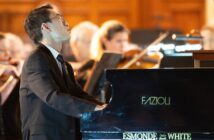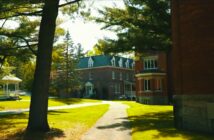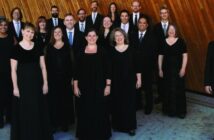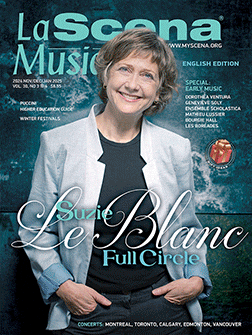This page is also available in / Cette page est également disponible en:
![]() Francais (French)
Francais (French)
On Sunday, May 1st at Salle Pierre Mercure, the Société de musique contemporaine du Québec will conclude its series of Portraits with Brasier, a concert dedicated to the music of Linda Bouchard. The five pieces on the programme will allow the audience to discover the powerful and colourful musical universe of this Quebec composer with an atypical career, based in Montreal, San Francisco and New York.
Linda Bouchard’s musical universe is deeply influenced by her many travels. After a short stay in Paris, in 1979 she lived in New York for more than ten years. There she discovered a vibrant cultural life which enabled her to appreciate the specificities of North American music, particularly its relationship to rhythm and pulse, which is very different from the European heritage: “The choice to stay in America had a major impact on my music. In North America great importance is placed on rhythm: jazz, pop music, minimalist music … Although I am not directly influenced by jazz, it is a musical genre that has nourished me: the energy, the density, the fluidity in the phrasing are elements that I try to transmit in my music. Despite this anchoring in the United States (punctuated by a return to Montreal in the 1990s, then a move to San Francisco in 1997), Linda Bouchard remains fully attached to her roots: “I am a Quebecer and I identify myself as such. I have spent most of my life in the United States, but Americans regard me as a Canadian composer.”
Linda Bouchard’s music is characterized by its density, its richness of texture and its rhythmic energy. Her writing in layers and blocks of sound, influenced in particular by Edgar Varèse, frees itself from introductions and developments in order to favour formal discontinuity and the immediacy of musical expression. “I write a work so that the listener can create a sound image of a journey, but I do not try to tell a story. The experience of life is not linear, it is constructed by an amalgam of several feelings. In this sense, my musical writing is not continuous: one could say that it is closer to poetry than to the novel.”
The five pieces on the Brasier programme, written between 1996 and today, show an aesthetic evolution of great coherence, driven by the same quest: the constant search for energy, movement and vitality. “I have always sought the same thing in my music, since my very first work, even if this search has been articulated in different ways and taken all sorts of forms.”
Bouchard’s musical universe is traversed by a momentum, a perpetual flow, which seems to reflect the movement of natural elements: thus, Liquid States (2004, for chamber orchestra) is “inspired by my fascination with water in all its forms, forces and textures.” Refraction (2015, for string orchestra) “explores the idea of water and light. This work tries to capture that moment when a wave is refracted, when its form changes through a piece ‘very different from others, marked by its interiority and the importance of silence.” Brasier (2001, for chamber orchestra) is based on the observation of fire on different scales. It proposes “three experiences of fire: the flame observed from the outside (represented by white noise); the inside of the fire (the redness of the inferno), and then the memory”.
This interplay between the forces of nature on the one hand and reflections on memory and remembrance on the other is also at the heart of Fracture, Bouchard’s new work which will be premiered by the SMCQ ensemble at this concert. This piece, which is almost identical to the instrumentation of Béla Bartók’s Music for Strings, Percussion and Celesta, was composed during the previous lockdowns: “It is a work inspired by the shock of the Covid 19 pandemic. We became aware of our inter-connectedness like never before: all of a sudden, everything stopped, and I felt a break, an almost physical dissolution in human movement.” The aesthetic project of Fracture combines the planetary shock associated with the pandemic with the representation of a seismic fault: “I explored the idea of the seismic fault and the planetary fault that we were experiencing during the pandemic. In Fracture I tried to capture the moment when something breaks: a huge noise, a break, and a scattering that makes us dizzy. This work, described by Linda Bouchard as;”my most daring and risky piece,” ends despite everything with: “a memory, a noise which incorporates all the colours and brings us back to life, to breath, to hope”.
Her discovery of digital tools in the early 2000s enabled Bouchard to renew her creative approach, offering her: “a new conception of gesture, as well as a new relationship to the integration of noise and sound textures. New technologies allow us to be less locked into the history of melody and harmony, and offer us a new relationship to sound. However, despite exploring new facets of musical composition (creation of multimedia works, creation of real-time graphic notation software and numerous artistic collaborations) Linda Bouchard remains very attached to instrumental writing and concert music. This latest SMCQ Portrait brings us the opportunity to fully explore the rich and daring ensemble music of this eclectic composer.
Brasier — Portrait de Linda Bouchard
Salle Pierre-Mercure – Centre Pierre-Péladeau
Sunday, May 1, 2022 3:00 pm
http://smcq.qc.ca/smcq/fr/evenement/43756/brasier-portrait-de-linda-bouchard
This page is also available in / Cette page est également disponible en:
![]() Francais (French)
Francais (French)













